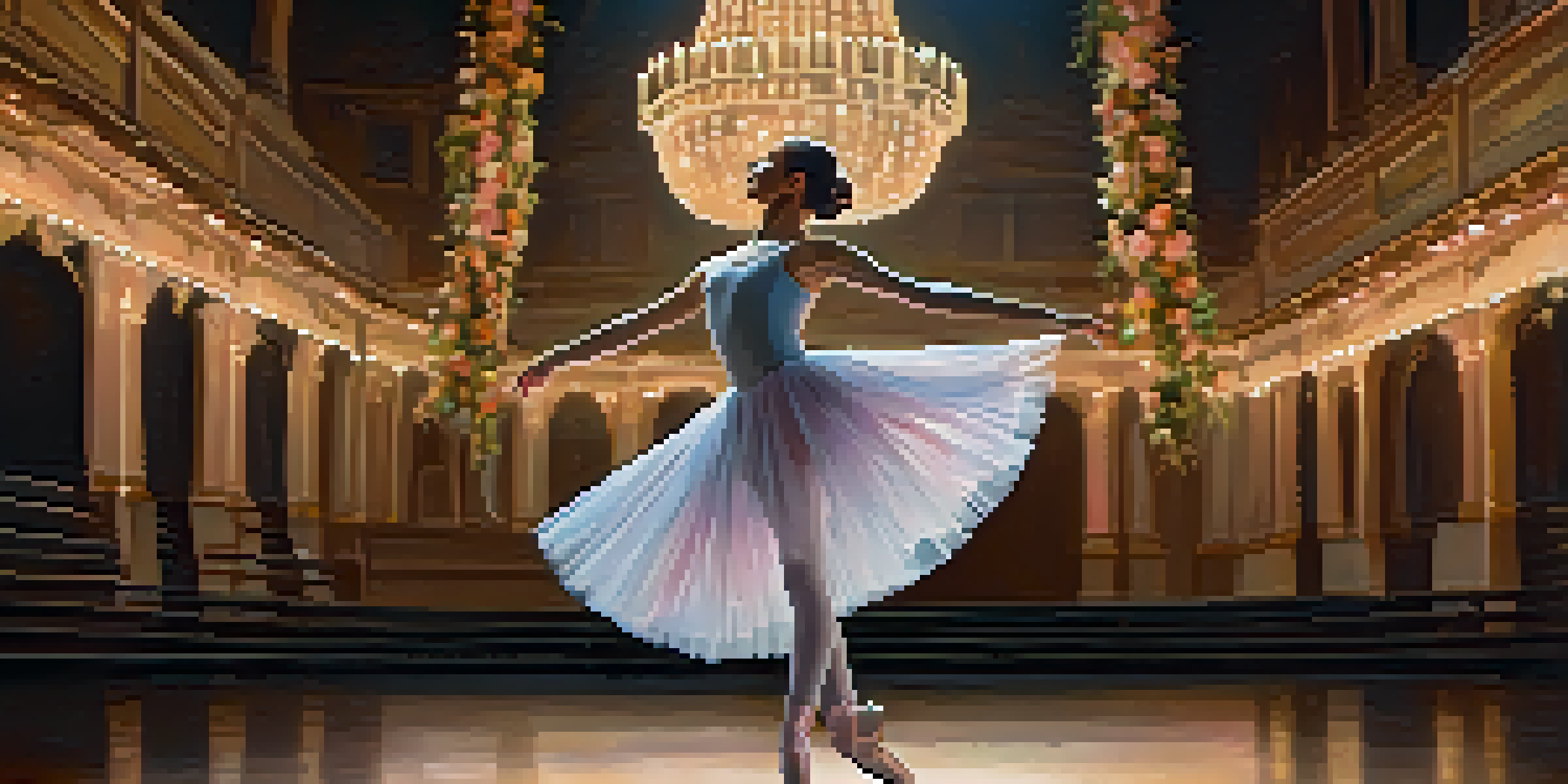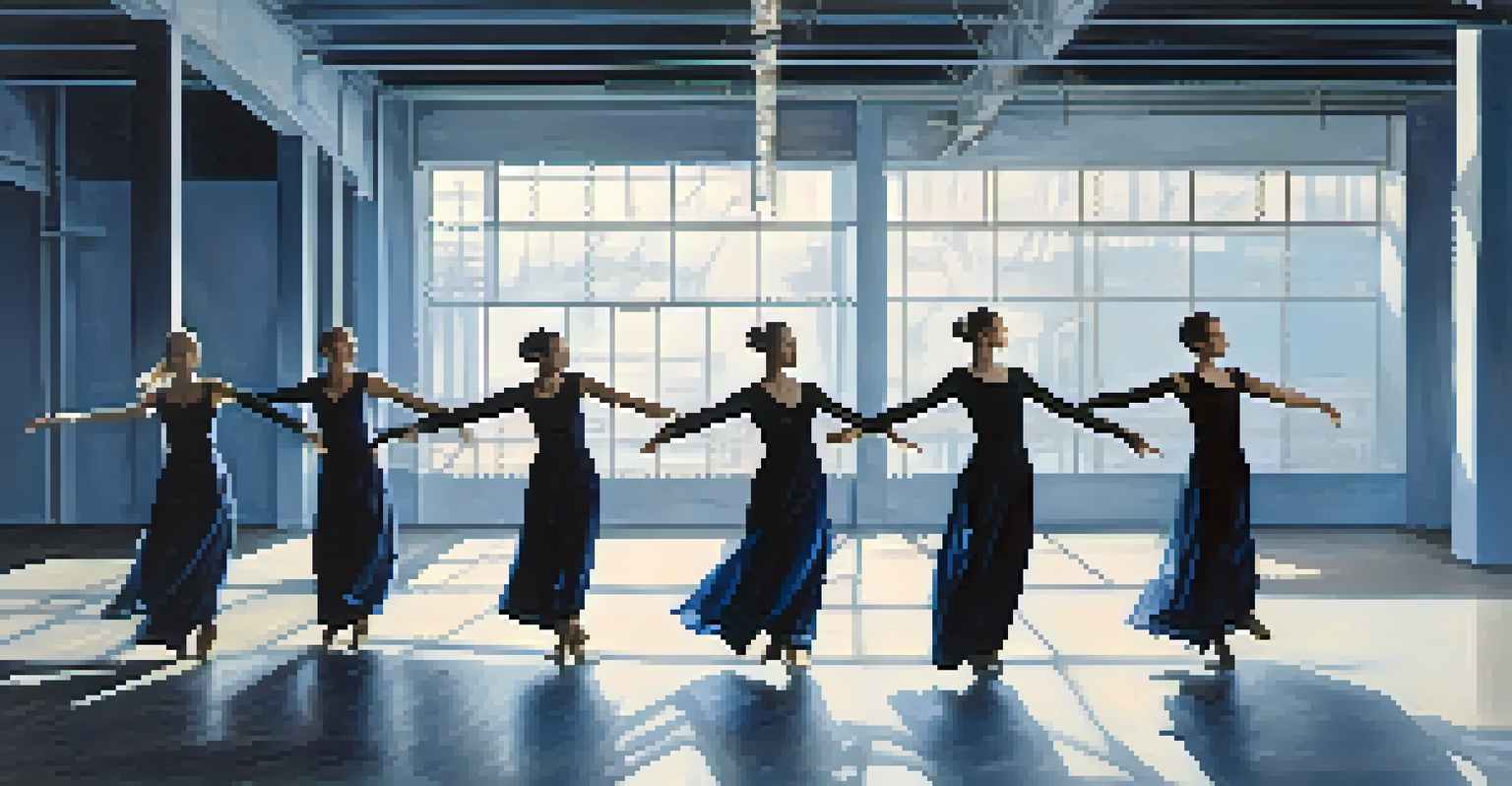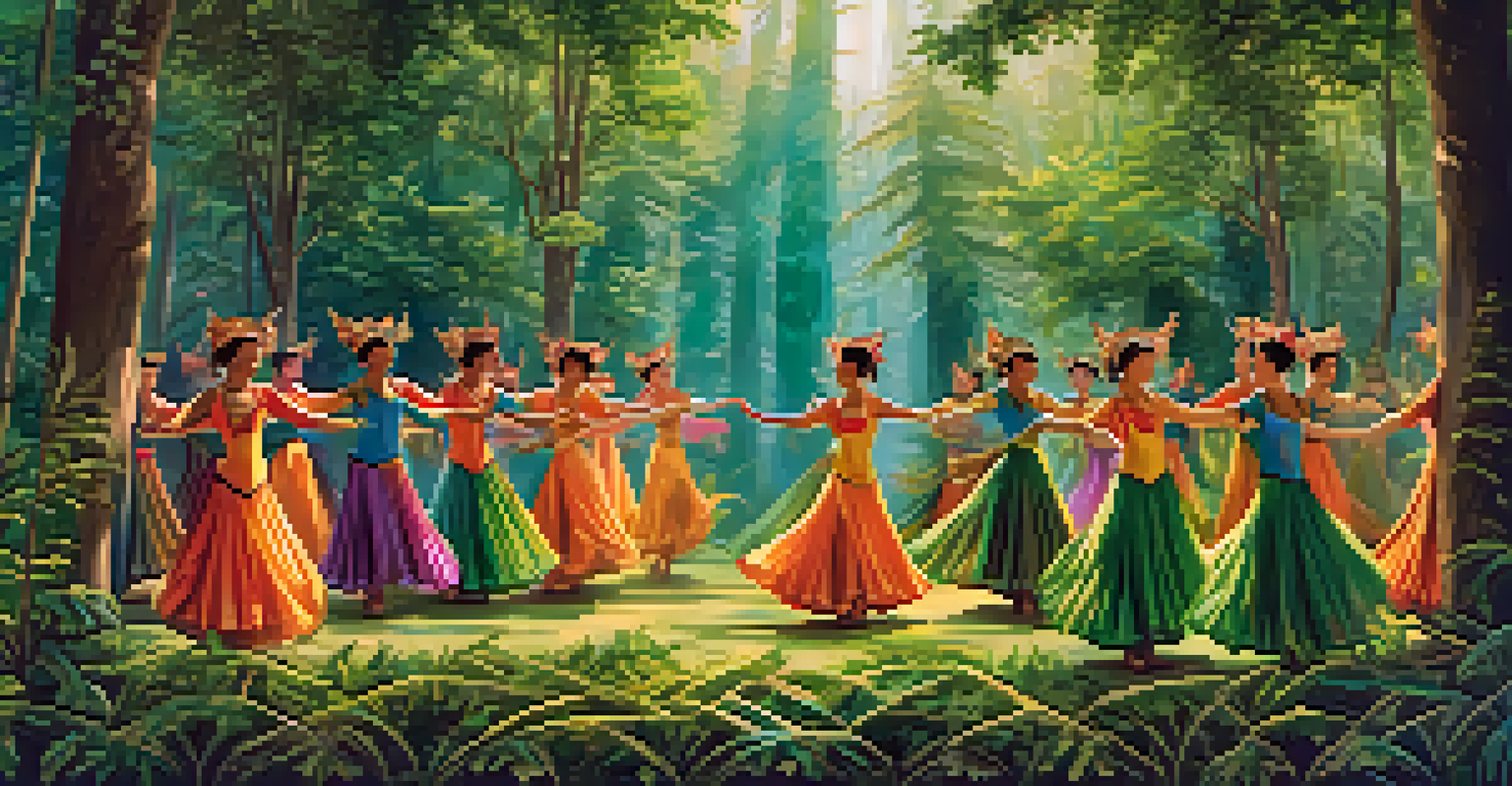The Role of Visual Aesthetics in Dance Performances

Understanding Visual Aesthetics in Dance
Visual aesthetics in dance refer to the elements that create beauty and emotional resonance during a performance. This includes the choreography, costumes, lighting, and overall staging. Each of these components plays a crucial role in how the audience perceives the dance, transforming mere movement into a rich sensory experience.
Dance is the hidden language of the soul.
When dancers take the stage, they are not just performing moves; they are telling a story through visual means. This storytelling is deeply enhanced by how the dancers appear, the colors they wear, and how the lighting highlights their movements. A well-thought-out aesthetic can evoke feelings of joy, sadness, or even nostalgia, allowing the audience to connect on a deeper level.
For instance, think of a ballet performance where dancers wear flowing, soft-colored costumes against a dark backdrop. This contrast not only emphasizes the elegance of their movements but also creates a dreamlike atmosphere. Such visual elements are pivotal in setting the mood and drawing the audience into the narrative.
The Impact of Costumes on Dance
Costumes are more than just clothing; they are a vital part of the storytelling in dance. The right costume can reflect the character’s personality, the theme of the performance, and even historical context. For example, a traditional Indian dance might feature elaborate, colorful attire that not only looks stunning but also has cultural significance.

Moreover, costumes can enhance movement and create visual effects that captivate the audience. A dancer in a flowing skirt might create beautiful lines as they twirl, while a fitted outfit can showcase athleticism and precision. Each choice made in costume design can significantly influence how the dance is perceived.
Visuals Enhance Dance Storytelling
Elements like costumes, lighting, and stage design play a crucial role in creating emotional resonance and enhancing the narrative of a dance performance.
When thinking about modern dance, consider how minimalist costumes allow the focus to remain on the body’s movements. This can create an intimate atmosphere, drawing the audience’s attention directly to the dance itself rather than any distractions. Ultimately, costumes serve as an essential tool in conveying the essence of the performance.
Lighting's Role in Dance Aesthetics
Lighting plays a crucial role in setting the mood and atmosphere of a dance performance. It can highlight specific movements, create dramatic effects, or even transport the audience to different times or places. A well-placed spotlight can draw attention to a solo dancer, while softer lights can create a more intimate setting for group performances.
The only way to make sense out of change is to plunge into it, move with it, and join the dance.
Different colors and intensities of light can evoke various emotions. For example, warm yellow tones might create a sense of joy and warmth, while cool blue hues can evoke feelings of calmness or melancholy. This strategic use of lighting helps to enhance the overall aesthetic experience of the performance.
Imagine a contemporary dance piece performed under stark, harsh lighting versus one enveloped in soft, warm hues. The emotional impact on the audience can be dramatically different, illustrating how lighting is a key player in the visual storytelling of dance. It’s a powerful tool that, when used effectively, can elevate a performance to new heights.
Choreography and Its Visual Elements
Choreography is the blueprint of any dance performance, dictating the movements and formations that dancers will execute. However, it's not just about the steps; it's also about how those movements visually connect and flow together. A well-crafted choreography can create stunning visual patterns that captivate the audience’s attention.
For instance, consider a dance that incorporates formations that shift seamlessly from one shape to another. This not only showcases the dancers' technical skills but also creates a visual feast that engages the audience. Each transition can tell a part of the story, making choreography a vital component of visual aesthetics.
Costumes Reflect Character and Theme
Costumes are essential in conveying a dancer's personality and the overall theme, significantly influencing audience perception.
Furthermore, the dynamics of the choreography—such as the contrast between sharp, staccato movements and smooth, flowing ones—can add depth and variety to the performance. This interplay of movement styles enriches the visual experience and keeps the audience engaged throughout.
The Importance of Stage Design
Stage design is an often-overlooked element in dance performances, yet it has a significant impact on the overall aesthetic experience. The set can provide context, create a backdrop for the dancers, and even influence the mood of the performance. A thoughtfully designed stage can transport the audience into the world of the dance.
For example, a performance set in a forest might include trees and natural elements, creating an immersive experience for the audience. This not only enhances the visual appeal but also supports the narrative of the dance. The stage becomes an extension of the dance itself, contributing to the storytelling.
Moreover, as the performance unfolds, the stage design can change, adding layers to the visual experience. This dynamic interaction between the dancers and their environment can lead to a richer understanding of the performance. Ultimately, stage design is a critical aspect of creating a memorable aesthetic in dance.
Audience Engagement Through Visuals
Visual aesthetics play a crucial role in audience engagement during dance performances. When the audience is captivated by the visuals, they are more likely to connect emotionally with the dance. This connection fosters a deeper appreciation for the art form, elevating the entire experience.
For example, consider a performance where the dancers interact with vibrant visual projections. This can create a multi-sensory experience that not only enhances the performance but also keeps the audience on the edge of their seats. Such innovative approaches to visual aesthetics can captivate audiences of all ages.
Technology Shapes Dance Aesthetics
With advancements in AR and VR, the future of dance visuals promises immersive experiences that elevate storytelling and audience engagement.
Moreover, an engaging visual experience can lead to lasting memories. People often recall how a performance made them feel based on its visual elements, whether it was the breathtaking costumes or the stunning lighting. When dance is combined with powerful visuals, it leaves a profound impression that resonates long after the curtain falls.
The Future of Visual Aesthetics in Dance
As technology continues to evolve, the future of visual aesthetics in dance performances is looking more exciting than ever. Innovations like augmented reality (AR) and virtual reality (VR) are beginning to influence how dance is presented and experienced. These technologies can create immersive environments that enhance the visual storytelling of dance.
Imagine attending a dance performance where you can experience different visual perspectives through VR headsets, allowing you to see the performance from various angles. This not only offers a unique viewing experience but also encourages a deeper engagement with the art form. The possibilities are endless as technology continues to advance.

In addition, we may see more collaborations between choreographers and visual artists, leading to groundbreaking performances that blur the lines between dance and visual art. This fusion has the potential to create a new era in dance, where visual aesthetics are not just an enhancement but a core part of the performance. The future of dance is vibrant and filled with endless creative possibilities.